
Alteration by Phil Nesmith

Alteration by Phil Nesmith

Alteration by Phil Nesmith
**** More burning luxury can be found here. ****


Alteration by Phil Nesmith

Alteration by Phil Nesmith

Alteration by Phil Nesmith
**** More burning luxury can be found here. ****
The end of 2013 and the first week of 2014 has found me in a strange, but I believe ultimately a positive and productive mental space. Having felt constrained by my own feelings about photography I have been working at a quick clip to find direction. This expenditure of energy has been someway unfocused with the objective to abandon my normal process of over analysis and evaluation which often results in creative paralysis and total inaction.

I am reminded of some ideas about the first steps of the creative process that American choreographer Twyla Tharp wrote in her book on the creative habit:
The first steps of a creative act are like groping in the dark: random and chaotic, feverish and fearful, a lot of busy-ness with no apparent or definable end in sight.
You need a tangible idea to get you going. The idea, however minuscule, is what turns the verb into a noun – paint into a painting, sculpt into sculpture, write into writing, dance into a dance.
I call it scratching. You know how you scratch at lottery tickets to see if you’ve won? That’s what I’m doing when I begin a piece. I’m digging through everything to find something. It’s like clawing at the side of a mountain trying to get a toehold, a grip, some sort of traction to keep moving upward and onward.
Scratching can look like borrowing or appropriating, but it’s an essential part of creativity. It’s primal, and very private. It’s a way of saying to the gods, “Oh, don’t mind me, I’ll just wander these back hallways…” and then grabbing that piece of fire an running like hell.
So to use Twyla’s term, I have definitely been scratching the past couple of weeks. I set myself three guidelines to follow during this process. The first one was to not evaluate if something was good enough, or serious enough to do. The second was that I could not make any new photographic source imagery, that I should rely on existing imagery created by others, or in the most desperate cases use old stuff I had laying around. Lastly I should employ PHYSICAL alterations to the images I selected to create something new. The series of burning cars made from advertisements from the 1960s, 70s, and 80s are some of my favorite initial results.
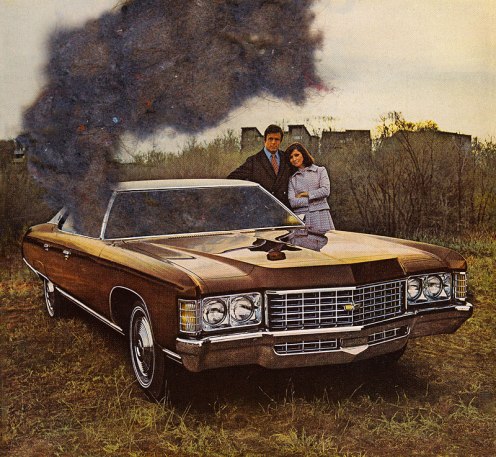
Alteration by Phil Nesmith
Dryer lint on vintage automobile advertisement.
Historically I have not been very drawn to making images of people which is evident if you plow through the years worth of post on this blog or troll the work on my site. But when I examine the people images by others that draw my attention they are often the ones in which the identity of the individuals in the frame are obscured by accident, intent of the sitter, or after the fact by some other agent. This affection is connected to a general interest that I have about identity. A currently simmering project explores specific objects and connections to private/public identity and personal myth of the American soldier.
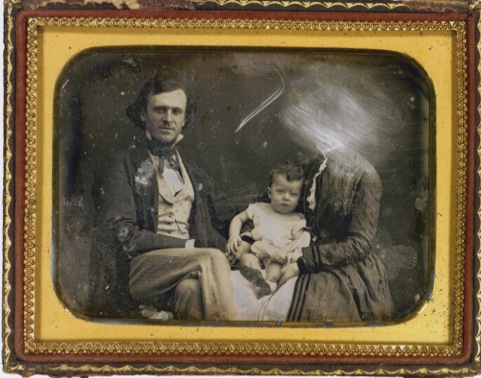
Anonymous
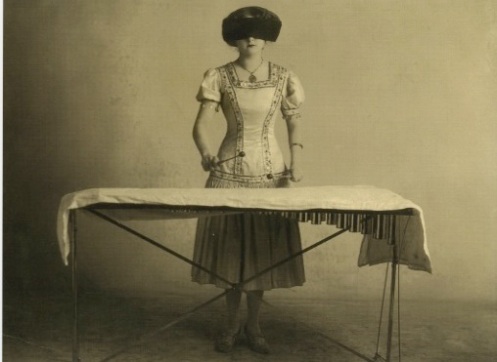
Anonymous
The three images presented below are a collection of old wet collodion ambrotype and tintype portraits that I made back in 2008 and 2012. Versions of these images that have not been altered can be found in the older regions of this blog (which I will let you explore to find). The obscuring of the specific identifying facial features originally began by using shallow depth of field, providing only enough visual information to hint at the sitters identity but focusing the viewers gaze on the objects the sitter was presenting for inspection. I abandoned this project shortly after it began, but something about the obscuring, and alteration or obliteration of the recognizable physical identity stayed in my thoughts.

©2014 Phil D. Nesmith
Acrylic and gold leaf on 7×5″ ambrotype.
During the summer of 2013 a spontaneous action led to the creation of a number of experiments in which I was digitally manipulating historical American Civil War portraits to obscure the physical identities of the sitters, yet creating something of an alternate personality by the use of shape and color. An example can be seen here and a more comprehensive listing of other posted images from this exploration can be located here.

©2014 Phil D. Nesmith
Acrylic on 7×5″ ambrotype.
The three altered portraits presented here are the result of my latest “scratching” session. Acrylic directly applied to unique wet collodion images has been employed to further obscure the physical identity of the sitters. This exercise served two purposes, that of shattering my worship of the pristine in-camera created exposure and forcing myself to revisit old images made for the purpose of exploring the same concept and extending the visualization with the application of an additional physical action.
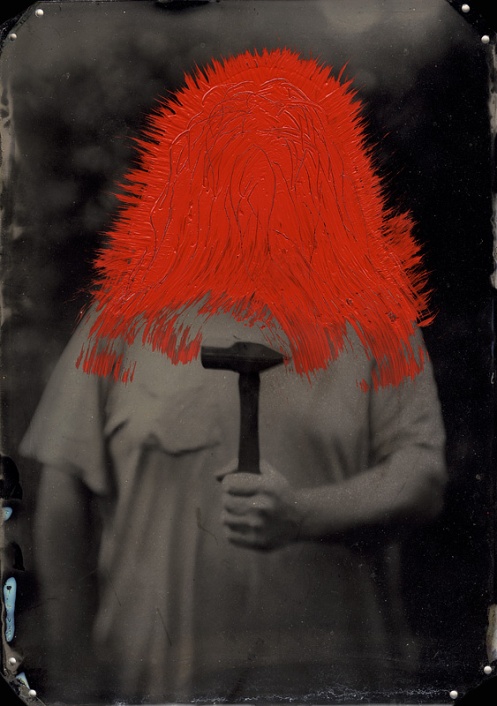
© 2014 Phil D. Nesmith
Acrylic on 7×5″ tintype.
As always I have many readings going at once. I often start and stop books and mags multiple times, although a straight read through is not unheard of. Snippets of the following are currently rolling around in my head.






The following images – I view them as sketches – are the result of a recent multiple day play season. Driven by a fascination of dryer lint and a collection of automobile ads and other imagery from the 1960s, 70s, and 80s. I sat down to make something. Anything. Not something intended to be serious, with no direction, just to blindly make. To free my imagination to the actions I remember being so common when I was a child. I needed to end a long stretch of inactivity. Well, below are some of the results that fall into a nice grouping.

Alteration by Phil Nesmith
After an assignment that I gave to my students, and the resulting conversations I have had growing interest in appropriation, the life of a photograph, what happens through the process of rephotographing a photograph, and adding three dimensional objects to images. Many artist have explored appropriation in the creation of their work, Richard Prince, Sherry Levine, Andy Warhol, Jeff Koons, and Louise Lawler, are but a few. My interest in this is being driven by a growing change in the my relationship with photography and photographic image making that seems to have started a year or more ago.
Currently I am not in a position to put my thoughts about my relationship with photography into words because I don’t know what it is yet. I know what it once was, but transition is occurring. There has been a growing boredom in the act of pointing the magic box at stuff. Part of me is frightened to read that last sentence, yet I know that my photographic work has always been about much more than pointing the box…

Alteration by Phil Nesmith

Alteration by Phil Nesmith

Alteration by Phil Nesmith

Alteration by Phil Nesmith

Alteration by Phil Nesmith

Alteration by Phil Nesmith

Alteration by Phil Nesmith

Alteration by Phil Nesmith

Alteration by Phil Nesmith
**** MORE CARS CAN BE FOUND HERE ****
For days I have been trying to put my finger on, as it were, the source of a nagging feeling I have been having since playing around with the idea behind the Surplus project. The tugging in my mind was that of familiarity, that sensation that your eyes have already seen what you happen to now be creating. Conjure that feeling we commonly associate with deja vu and you will have the recurring sensation that I have had.
So, I have been on the hunt of the source of my recurring phantoms of recognition. Thinking I had seen another biographical object project like the one I am tinkering with I canvassed with web with relentless search-and-destroy Google queries. Each one came up very short. Each negative inquiry actually being a positive outcome.
Then suddenly, like the realization that you forgot to renew your vehicle registration while halfway through a 1000 mile road trip, I saw a vision of an antipersonnel mine. The mine floated in the darkness of my sealed cranium, its strange bright color popping against the void.

©2013 Phil D. Nesmith
I had located the source of my unsettling feelings! The project that had been lodged deep in my mind and reawakened by the creation of my recent images is one by Raphael Dallaporta named Antipersonnel. I had first been introduced to this work because of its inclusion in Aperture’s reGeneration published in 2005. The areas explored by Antipersonnel and Surplus are vastly different, and although the image creation methods are not the same, the resulting aesthetics are. Now the question is one of a way forward.
During the week of Veterans Day I began a new project, one born from the exploration of my own past. I am not sure about where the project will go, if anywhere at all but below I have provided the statement for the project as I understand it at this moment.

©2013 Phil D. Nesmith
This project inverts the photographic portrait of the modern soldier by imaging the relics and artifacts they selected, collected, and salvaged as markers of their own personal progression through armed conflict. The images, curated by the soldiers themselves, create an alternative vision of history as it is broadly painted by nightly news and history books. These images are at once deeply personal and impersonal. They are objects that mark significant places, actions, decisions, consequences, and milestones, but also the more mundane yet more frequent realities of armed service. These items are often labeled as war trophies or souvenirs but these labels are too often limiting of the wider range of functions the collected objects serve for the individual and their motivation for preserving them.
I am interested in objects that take on the power of significance for individuals intimately and intricately involved with armed conflict, specifically the soldier, that at the end of their military life finds themselves with collections of objects, collections that are not categorized as such for the person to whom they belong. What motivates them to reach down into the dirt and pull a piece of shrapnel from the earth and place it in their pack, to be carried, transferred, stored, and shuffled about for years to emerge a lifetime later and sometimes only in private. What of the talismans and charms crafted, assembled, gifted, and sometimes found that are worn against the body as part of some conscious or subconscious personal protection ritual? Biographical objects can and are used to record, validate, and transmit an individual’s personal history or myth. Yet little is known or shown of modern soldiers’ biographical objects. This is an interesting revelation given the past decade of “warrior” worship found in the United States after 9/11.
Most of the objects in the series were necessities, or near-necessities for the situations at hand when they were used, but removed from the context of conflict they can often be described at trash or simply “surplus”. It is the act of saving, packing away – the selection for preservation that hints at something deeper about the soldier him/herself. These objects construct a web bridging matter, meaning, and personal narrative, and collective history. These objects, which have been squirreled away in trunks, ruck sacks, duffel bags, kit bags, and foot lockers, used in a context of conflict have become objects of fascination and endless consideration.
More words and images can be found at the following links:
The things they carried were largely determined by necessity. Among the necessities or near-necessities were the P-38 can openers, pocket knives, heat tabs, wristwatches, dog tags, mosquito repellent, chewing gum, candy, cigarettes, salt tablets, packets of Kool-Aid, lighters, matches, sewing kits, Military Payment Certificates, C rations, and two or three canteens of water. Together, these items weighed between 12 and 18 pounds, depending upon a man’s habits or rate of metabolism.
©2013 Phil D. Nesmith
Henry Dobbins, who was a big man, carried extra rations; he was especially fond of canned peaches in heavy syrup over pound cake. Dave Jensen, who practiced field hygiene, carried a toothbrush, dental floss, and several hotel-sized bars of soaphe’d stolen on R&R in Sydney, Australia. Ted Lavender, who was scared, carried tranquilizers until he was shot in the head outside the village of Than Khe in mid-April. By necessity, and because it was SOP, they all carried stell helmets that weighed 5 pounds including the liner and camouflage cover. They carried the standard fatigue jackets and trousers. Very few carried underwear. On their feet they carried jungle boots – 2.1 pounds – and Dave Jensen carried three pairs of socks ans a can of Dr. Scholl’s foot powder as a precaution against trench foot.
©2013 Phil D. Nesmith
Until he was shot, Ted Lavender carried 6 or 7 ounces of premium dope, which for him was a necessity. Mitchell Sanders, the RTO, carried condoms. Norman Bowker carried a diary. Rat Kiley carried comic books. Kiowa, a devout Baptist, carried an illustrated New Testament that had been presented to him by his father, who taught Sunday school in Oklahoma City, Oklahoma. As a hedge against bad times, however, Kiowa also carried his grandmother’s distrust of the white man, his grandfather’s old hunting hatchet. Necessity dictated. Because the land was mined and booby-trapped, it was SOP for each man to carry a steel-centered, nylon-covered flak jacket, which weighed 6.7 pounds, but which on hot days seemed much heavier. Because you could die so quickly, each man carried at least one large compress bandage, usually in the helmet band for easy access. Because the nights were cold, and because the monsoons were wet, each carried a green plastic poncho that could be used as a raincoat or groundsheet or makeshift tent. With its quilted liner, the poncho weighed almost 2 pounds, but it was worth every ounce. In April, for instance, when Ted Lavender was shot, they used his poncho to wrap him up, then carry him across the paddy, then lift him into the chopper that took him away.
Tim O’Brien / The Things They Carried
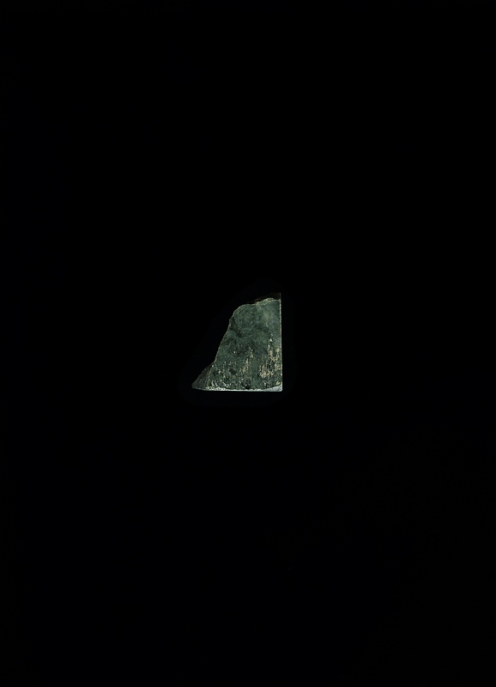
©2013 Phil D. Nesmith

Wet collodion glass negative by an unknown photographer. Manipulation by Phil Nesmith (June 2013).

Wet collodion glass negative by the Brady National Photographic Art Gallery – 1860/65.
Manipulation by Phil Nesmith (June 2013).